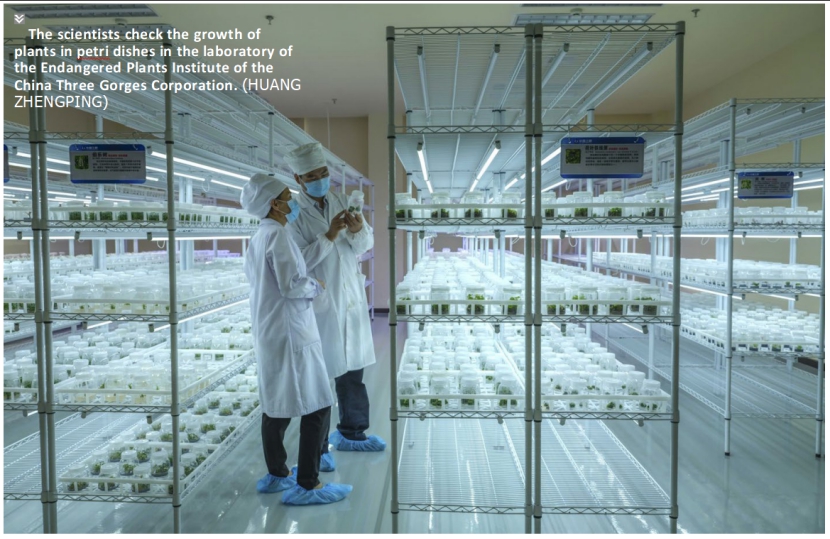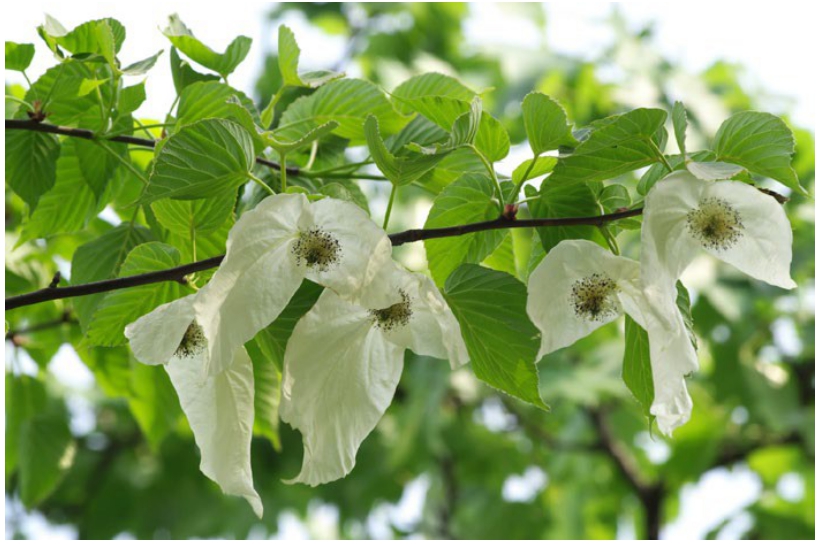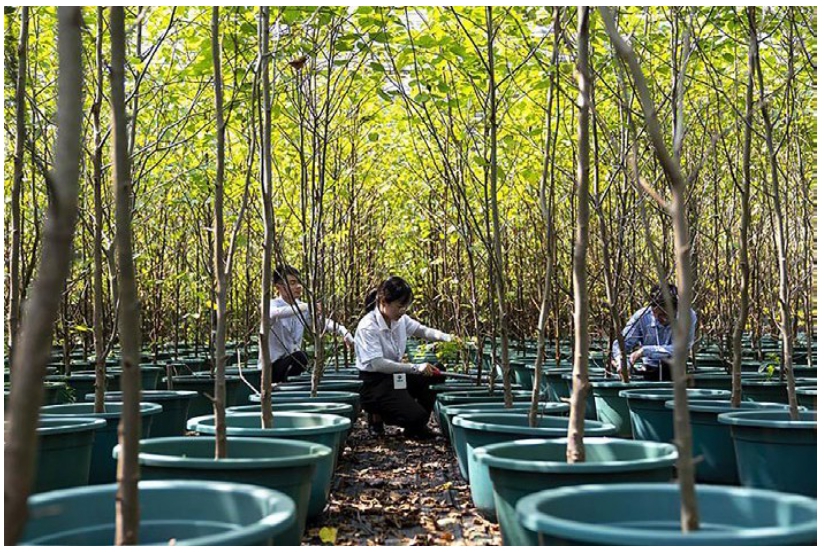from:China Electricity Councildate:2020-10-27
The Endangered Plants Institute of the China Three Gorges Corporation (hereinafter the “Plants Institute”) is situated in a green stretch upstream of the right bank of the Three Gorges Project. Every spring, a special spring plowing occurs there. After 10 years of efforts, 1,006 species of endangered plants from the Yangtze River area grow there.The people doing the plowing are not farmers, but scientists from the Plants Institute.
When construction of the Three Gorges Dam began, some experts warned that 560 species of terrestrial plants would be affected. Among the endangered species of plants distributed along the banks of the Yangtze River, Myricaria laxiflora, a shrub, and Adiantum reniforme, a fossil fern, were identified as at risk of catastrophic destruction. To save the precious plants, the China Three Gorges Corporation (CTG) founded the Three Gorges Nursery Center in 2007, the predecessor of the Plants Institute. The institute focuses on the ex-situ conservation, transplant, tissue culture and molecular genetics of endangered plants.
Hard and Hazardous Research
Huang Guiyun, deputy director of the Plants Institute, began studying M. laxiflora with a team as early as 2000 and gained considerable first-hand information about the shrub species.
“The field research was hard and hazardous,” said Huang. “We had to carry equipment and luggage weighing about 30 to 40 kilograms deep into the mountains and stay there for half a year. We had to navigate all sorts of difficulties and dangers including walking through dense forest, subsisting on instant food, drinking river water, sleeping in tents, and avoiding poisonous snakes, insect bites, and blood-sucking leeches.” Huang asserted that no one could have completed the mission without passion for the cause.
In a field investigation, Huang discovered the D. involucrate, an endangered dove-tree species under national first-level protection, on a cliff over 2,000 meters high. “We had to protect it from landslides,” she said. The researchers set up tents atop the mountain and rappelled down to observe and record its growth. To save the plant from destruction in a landslide, they piled a protective shield of rocks on the cliff and fixed it with thick ropes. The effort has continued for two years.
Endangered plant such as M. laxiflora and D. involucrate can grow in every corner of the Yangtze River basin, including places that can be extremely dangerous for researchers. Huang once stepped on a loose rock and fell when doing research. Fortunately, she was saved by a tree branch. “It took more than 10 hours for the local people to get me down from the mountain,” she recalled. Huang suffered a broken ankle in the incident.
New Home Sweet Home
“We continued researching M. laxiflora for over three years before moving them to a new home.” Huang Guiyun not only transferred the plants and surrounding vegetation, but also brought back habitat soil to make sure the plants would be viable in their new home. “We didn’t dare move every plant we could find all at once for fear they might all die. It took us 10 years to move the more than 800 plants to our institute.”
The scientists at the Plants Institute studied M. laxiflora by applying various vegetative reproduction methods including pruning and cloning. “We have cultivated 22,000 plants of M. laxiflora so far,” Huang said.
Huang also devoted considerable effort to moving and preserving D. involucrate. She visited Beijing to consult with experts at the Chinese Academy of Sciences before hammering out a phase-by-phase plan. The precious dove-tree was scheduled for relocation from an altitude of over 2,000 meters down to 1,000 meters, then to 500 meters, and finally to the Plants Institute. Each phase was planned for two years to give the trees time to acclimate to altitude and surroundings, which means the complete journey to their new home would take eight years. The scientists also kept monitoring the plants year-round.
To the scientists’ relief, the D. involucrate plants bloomed and presented beautiful, white dove-like flowers in just the second year of the move. After years of domestication techniques, the species was thriving in its new home at lower altitudes.
Flourishing Fossil Fern
Adiantum reniforme, or lotus-leaved maidenhair fern, is a rare species of great medicinal value and aesthetic merit. After many years of searching, Huang had located only about 200 plants of the fern on the lower Zigui River. “We consulted with relevant experts before moving them to the Plants Institute,” she said. “Petri dishes growing the fern seedlings were placed on shelves of the institute’s culture room.”
“A. reniforme goes dormant in winter and grows best in summer,” Huang explained. “We put seedlings in thermostatic rooms where constant temperature and humidity are maintained to ensure they grow well all the time and maintain metabolic activity. This helped us learn growth patterns. Now, we can get them to produce spores three to four times a year.”
The scientists took great care of every hard-won sporophyte. They recorded monitoring data every two hours and even slept in the lab. In 2019, some experts visited the institute and reported that these precious plants were all growing and reproducing well. “I worried the plants would be dying, but they are flourishing,” one joked.
“These plants are like our babies,” gushed Huang. “They don’t speak, but we need to read the information they present to us. If we give them what they need, they will grow, bloom, and provide everything they can for humans. Our work is rewarding for all involved.”
Modified to Multiply
Each summer, the water level of the Three Gorges Reservoir is lowered to 145 meters to make room for incoming floodwaters. As the dry season arrives after September, the reservoir’s water level rises to 175 meters. The change in the water level creates a so-called riparian zone, a 30-meter, non-vegetative buffer zone wrought with ecological damage.
During the natural migration of the M. laxiflora, the shrub species developed a unique growth pattern to adapt to the seasonal rise and fall of the Yangtze River waters. The plants become dormant when submerged in water in summer, and resume growth when the water recedes in winter. The pattern enabled the plants to endure floods and stay alive even when drowned in water, which makes it ideal for sand dune stabilization along banks.
In the riparian zone of the Three Gorges Reservoir, however, water rises in winter and falls in the summer. So, the scientists began testing methods to maintain their growth in summer conditions. “We planted them on land and applied many domestication measures to modify dormancy patterns,” explained Huang. Now, the M. laxiflora can “stay awake” in summer with a survival rate of over 90 percent. “This breakthrough filled some blanks in the study of plants in riparian zones. It is significant, because maintaining vegetation in riparian zones is a problem not only in the Three Gorges Dam but also in many other places around the world.
Today, over 3,000 modified M. laxiflora plants have been returned to their original home along the Yangtze River, marking the complete reconstruction of their life system.Valued for its effectiveness at soil conservation, more M. laxiflora plants are taking root in the broader area along the Yangtze River every day.
“I am just doing my best to preserve life and hope along the Yangtze River,” said Huang Guiyun.

The scientists check the growth of plants in petri dishes in the laboratory of the Endangered Plants Institute of the China Three Gorges Corporation. (HUANG ZHENGPING)

The dove-like flowers of D. involucrate.

Scientists remove weeds from nursery pots holding Davidia involucrate in the nursery base of the Endangered Plants Institute of the China Three Gorges Corporation, on August 6, 2020. (XIANG HONGMEI)
Tel:+86-25-84152563
Fax:+86-25-52146294
Email:export@hbtianrui.com
Address:Head Office: No.8 Chuangye Avenue, Economic Development Zone, Tianmen City, Hubei Province, China (Zip Code: 431700) Nanjing Office: Room 201-301, Building K10,15 Wanshou Road,Nanjing Area, China (Jiangsu) Pilot Free Trade Zone,Jiangsu Province,China (Zip Code:211899)
